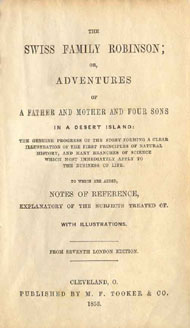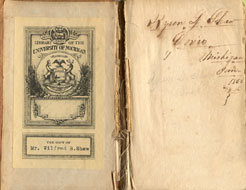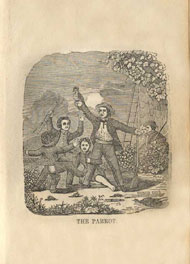 Wyss,
Johann David, 1743-1818. The Swiss Family Robinson; or, Adventures
of a Father and Mother and Four Sons in a Desert Island. The Genuine
Progress of the Story forming a clear Illustration of the First Principles
of Natural History, and Many Branches of Science which most immediately
apply to the Business of Life. From the seventh London edition.
Cleveland, Published by M.F. Tooker. 1853. Stereotyped by W. H. Shain,
at the Hudson Stereotype Foundry, Hudson, Ohio. Printed by Sawyer,
Ingersoll & Co., Steam Press, Pentagon. Wyss,
Johann David, 1743-1818. The Swiss Family Robinson; or, Adventures
of a Father and Mother and Four Sons in a Desert Island. The Genuine
Progress of the Story forming a clear Illustration of the First Principles
of Natural History, and Many Branches of Science which most immediately
apply to the Business of Life. From the seventh London edition.
Cleveland, Published by M.F. Tooker. 1853. Stereotyped by W. H. Shain,
at the Hudson Stereotype Foundry, Hudson, Ohio. Printed by Sawyer,
Ingersoll & Co., Steam Press, Pentagon.
This edition of the children’s classic, Swiss Family Robinson,
was published in Cleveland in 1853, having been printed at the “steam
press” in nearby Hudson. The copy at the University of Michigan
was proudly acquired by a 12-year-old boy living in Doris, Michigan
(Ionia County), Byron L. Shaw, who signed the front inside
cover with the date January 1856.
 Swiss
Family Robinson, an adaptation of Daniel Defoe’s
Robinson Crusoe, was first published in 1812 and enjoyed
great success. A tale of a family shipwrecked and stranded on a
desert island, it is still to be found on many reading lists for
upper elementary and middle school students. In it, the characters
model both resourcefulness and adaptability while experiencing many
exciting adventures. Besides its entertainment value, this book
offered practical instructions on self-sufficiency, a trait highly
valued on America’s frontier in the mid-19th century. Swiss
Family Robinson, an adaptation of Daniel Defoe’s
Robinson Crusoe, was first published in 1812 and enjoyed
great success. A tale of a family shipwrecked and stranded on a
desert island, it is still to be found on many reading lists for
upper elementary and middle school students. In it, the characters
model both resourcefulness and adaptability while experiencing many
exciting adventures. Besides its entertainment value, this book
offered practical instructions on self-sufficiency, a trait highly
valued on America’s frontier in the mid-19th century.
 The
illustrations in this edition consist of simple woodcuts interspersed
with the story. Some of the illustrations are very similar to those
that appeared in a Boston edition of 1832, which also claimed to
be based on the seventh London edition. The
illustrations in this edition consist of simple woodcuts interspersed
with the story. Some of the illustrations are very similar to those
that appeared in a Boston edition of 1832, which also claimed to
be based on the seventh London edition.
This volume is part of the Hubbard Imaginary Voyages Collection
at the University of Michigan, one of the world’s largest collections
of items relating to Robinson Crusoe. The Collection was
donated by Lucius L. Hubbard in the 1920s and now consists
of some 3000 volumes. It reflects the enthusiastic reception accorded
to Robinson Crusoe from its first appearance in 1719 to the
present, including translations, adaptations, spinoffs, film adaptations,
and references in popular culture such as advertisements, political
cartoons, and comic strips.
|